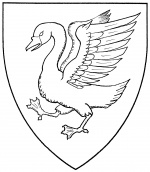Bird Postures
WARNING: Do not cite this page as a reference. This page is on this wiki only to make the content "searchable" and easier to find. If you find the information you seek here, go to the original sources to verify the information and use them for your documentation.
Period Illustrations:[edit | edit source]
Displayed:[edit | edit source]
| Zacharias Bartsch, 1567, eagle and demi-goat | Zacharias Bartsch, 1567, sickles and eagle displayed with mount |
| Zacharias Bartsch, 1567, der Rindtscheidt, possible noneagle displayed | BSB 312, Scheibler, 1450-1580, die Rindscheit, different version of the possible noneagle displayed |
| Zacharias | Zacharias |
| Zacharias Bartsch, 1567, f38r, demi-owl displayed, pink? | Zacharias Bartsch, 1567, f151r, gate/castle, dove displayed |
SENA[edit | edit source]
Armory Conflict (SENA A.5.G.7.a.)[edit | edit source]
"Changes that distinctly affect the number of extended wings (from wings folded to raised, or from wings seen on one side of the body to both sides) are sufficient for a distinct change." http://heraldry.sca.org/sena.html#A5G7a
Appendix L: A Partial List of Postures and Orientations[edit | edit source]
This is a list of postures and orientations that can be used to determine whether two charges or groups of charges conflict or whether there is a distinct change for posture/orientation. Animate Charges
B. Birds: The postures listed within each group generally conflict, though a distinct change may be given for facing to dexter or to sinister.
- close, naiant
- displayed, migrant
- volant
- rousant, rising, striking [rousant is basically the same as rising but refers to swans - http://mistholme.com/dictionary/swan/ ]
From the Quick Reference: Bird Postures[edit | edit source]
- http://heraldry.sca.org/armory/bird-postures.html
| Posture | Defining traits | stylised drawing | Example |
| Displayed | Wings and legs splayed |  |
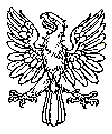
|
| Close | Wings close against the body and feet on ground |  |
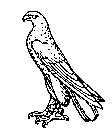
|
| Volant | Feet invisible, wings outstretched. Wings can be displayed or not. |  |
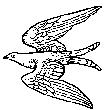
|
| Rising | Feet on ground, wings elevated or displayed, addorsed or not. |  |

|
| Close affronty or | |||
| Close guardant | Normally only for owls - this is their default posture |  |
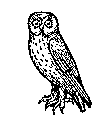
|
| Pride | seen only with Peacocks. Close affronty with tailfeathers displayed | 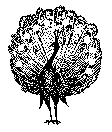
| |
| Vigilance | seen only with Cranes. Close with one leg raised, stone in claw | 
| |
| Vulning or Piety | seen only with Pelicans..normally with nest and chicks | 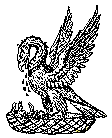
| |
From "Heraldry: Blazonry of Creatures[edit | edit source]
by Eldred Ælfwald
Beasts of the Air (birds or monsters that are mostly wing)
rising: wings are open, as if the bird is taking off. There are a variety of postures and wing positions associated with rising. In some cases the bird is seen from the side. In other cases it is seen from the front. The phoenix is always blazoned as rising and always seems to be displayed affronty. The head could be up or down.
addorsed: both wings are behind the bird's head in a natural posture. See displayed for additional modifiers.
displayed: wings outstretched to either side of the avian. When the wings are displayed or addorsed, there are two ways that they may be shown: elevated--with the wing tips up (typical of Continental armory);inverted--with wing tips down (typical of English armory). Within the SCA, there is no difference given between elevated and inverted wings.
close: wings are closed. A peacock close is blazoned pavonated. Close is a common attitude for "lesser" birds. Note: any raptor close will probably be blazoned as a falcon. A bat close will be depicted affronty, and an owl close is usually depicted guardant.
striking, rousant, trussing: raptor in flight with head down and talons out stretched to grasp. In period armory, this was blazoned as rousant or trussing. May be enhanced with another bird (usually lying close fesswise) as "preying upon an X".
affronty: as with land beasts, avians can be shown affronty. Some such as the owl and the bat are much more identifiable this way. However, their heads will typically be seen in profile.
statant:this posture is normally reserved for long-legged avians such as the heron and the crane.
in her piety: reserved for pelicans, the pelican is shown beak to breast with blood dropping to pelican chicks.
in its vigilance: reserved for cranes, it is shown with head up and one leg raised grasping a rock.
in his pride: reserved for peacocks, it is shown statant affronty with the tail feathers spread.
volant: as if the bird were in flight. There are a variety of ways to position the wings. The normally accepted practice is to show the bird as if it were banking or circling. When depicted as shown below, this matches standard period heraldic practice. Brooke-Little notes that this was once a synonym for rising but in modern heraldry volant is distingushed from risingby the bird's feet not being visible.
naiant: this is used in the SCA to describe waterfowl that are "swimming"
migrant: a bird in flight palewise, viewed from the top (similar to tergiant). This appears to be an SCA invention--and it is virtually indistinguishable from displayed. As of February 2020 - migrant no longer registerable
http://dragon_azure.tripod.com/UoA/AnimalBlazonry.html
Precedents:[edit | edit source]
Precedents of the SCA College of Arms - http://heraldry.sca.org/laurel/precedents.html
Morsulus Heralds Website - http://www.morsulus.org/ (to search the LoARs and Precedents)
Use the above links to be sure any precedents listed below haven't been superseded by newer precedents.
Definition:[edit | edit source]
December 2012 - Hummingbirds Volant, Rising, and Hovering[edit | edit source]
A question on one of this month's submissions caused us to investigate the postures of hummingbirds registered in the Society. There are currently 41 pieces of armory with one or more hummingbirds: 1 is close, 1 is migrant, 3 are displayed, 8 are blazoned as volant, 27 are blazoned as rising, and 1 is blazoned as hovering.
An examination of the volant, rising, and hovering hummingbirds showed that we have inconsistently blazoned the various postures. Birds in the hovering posture unique to the hummingbird - body erect but embowed, wings addorsed, tail tucked forward under the body - have been variously blazoned as rising or volant (and yes, once as hovering). We also found hummingbirds blazoned as volant that are in the posture the Society identifies as rising.
While the term hovering isn't an heraldic posture, neither is stooping or striking (which we equate, for conflict purposes, with volant bendwise and rising, respectively). While we are reluctant to use SCA-unique terminology in blazon, hovering is the best term that describes that unique hummingbird posture. We note that certain period heraldic charges had special terms for postures uniquely (at least in period heraldry) associated with them, for example, stags at gaze and goats clymant. In order to ensure that the emblazon is recreated from the blazon, we are adopting the term hovering for hummingbirds. The three postures can be described as:
- Hovering: the wings addorsed, the body sort of palewise but embowed, and the tail tucked forward under the belly. This term may only be applied to hummingbirds. It is granted no difference from rising.
- Rising: the body bendwise, wings elevated and addorsed. In other words, the bird is "taking off" from the ground. If present, the feet are shown beneath or slightly in front of the bird. The feet are generally absent for hummingbirds, though they are almost always present for other birds.
- Volant: the body is more or less horizontal, the wings spread on either side of the body. If the wings are addorsed this must be specified. A bird volant (wings spread) is a CD from a bird rising.
We wish to remind submitters that the use of a hummingbird is a step from period practice. http://heraldry.sca.org/loar/2007/12/07-12cl.html
March 2011 - vigilance only for cranes:[edit | edit source]
Constantine Trewpeny. Name and device. Per chevron sable and gules, three cranes in their vigilance argent. While the submitter wanted the birds blazoned as herons, they are unmistakably cranes: herons have a tuft of feathers on their head. They are also in a posture, in their vigilance, that is only used for cranes. http://heraldry.sca.org/loar/2011/03/11-03lar.html
October 2010 - stooping vs striking:[edit | edit source]
Padruig of Calontir. Per bend sinister gules and argent, a falcon stooping contourny counterchanged maintaining in its talons a bow and hammer azure, a bordure counterchanged. Blazoned on the Letter of Intent as striking, a bird in a striking posture has its head up and tail down, whereas a bird in a stooping posture has its head down and tail up, as in this depiction; more typically the feet in a stooping posture are swept back, not forward, but either is allowable. [[1]]
December 2007 - Hummingbird Postures:[edit | edit source]
From Wreath: Hummingbirds Volant, Rising, and Hovering A question on one of this month's submissions caused us to investigate the postures of hummingbirds registered in the Society. There are currently 41 pieces of armory with one or more hummingbirds: 1 is close, 1 is migrant, 3 are displayed, 8 are blazoned as volant, 27 are blazoned as rising, and 1 is blazoned as hovering.
An examination of the volant, rising, and hovering hummingbirds showed that we have inconsistently blazoned the various postures. Birds in the hovering posture unique to the hummingbird - body erect but embowed, wings addorsed, tail tucked forward under the body - have been variously blazoned as rising or volant (and yes, once as hovering). We also found hummingbirds blazoned as volant that are in the posture the Society identifies as rising.
- While the term hovering isn't an heraldic posture, neither is stooping or striking (which we equate, for conflict purposes, with volant bendwise and rising, respectively). While we are reluctant to use SCA-unique terminology in blazon, hovering is the best term that describes that unique hummingbird posture. We note that certain period heraldic charges had special terms for postures uniquely (at least in period heraldry) associated with them, for example, stags at gaze and goats clymant. In order to ensure that the emblazon is recreated from the blazon, we are adopting the term hovering for hummingbirds. The three postures can be described as:
- Hovering: the wings addorsed, the body sort of palewise but embowed, and the tail tucked forward under the belly. This term may only be applied to hummingbirds. It is granted no difference from rising.
- Rising: the body bendwise, wings elevated and addorsed. In other words, the bird is "taking off" from the ground. If present, the feet are shown beneath or slightly in front of the bird. The feet are generally absent for hummingbirds, though they are almost always present for other birds.
- Volant: the body is more or less horizontal, the wings spread on either side of the body. If the wings are addorsed this must be specified. A bird volant (wings spread) is a CD from a bird rising.
We wish to remind submitters that the use of a hummingbird is a step from period practice. http://heraldry.sca.org/loar/2007/12/07-12cl.html
February 2007 stooping vs striking:[edit | edit source]
Balin Kendrick. Quarterly azure and gules, two eagles stooping respectant and a two-horned anvil Or. As defined for SCA use (in the LoAR Cover Letters of July and Aug 1986), stooping is reserved for when the raptor is "dive-bombing", falling on its prey: wings swept back, body vertical or diagonal with head down. Striking is the moment when the raptor comes out of its stoop, its feet ready to grab or punch the prey: body diagonal with head up, heraldically equivalent to rising. http://heraldry.sca.org/loar/2007/02/07-02lar.html
November 2006 - displayed:[edit | edit source]
Syban Khal. Device. Sable, on a plate a Russian firebird volant palewise head to sinister gules within a bordure rayonny argent. "This device is returned for a redraw. ...In addition, the bird is not displayed, as blazoned on the LoI: that posture is specifically defined to have the feet stick out on either side of the body, and this bird has no feet." http://heraldry.sca.org/loar/2006/11/06-11lar.html
February 2002 - passant vs close:[edit | edit source]
"A bird passant, that is to say, with one leg raised, is considered an unblazoned variant of close" February 1996 LoAR & February 2002 LoAR
May 1980 - vigilance:[edit | edit source]
Kingdom of Ansteorra for The Sable Crane of Ansteorra. Or, a crane in its vigilance sable, armed, orbed, membered, crested and throated Or, fimbriated sable, bearing in its dexter claw a mullet of five greater and five lesser points sable. Note: A crane in its vigilance is statant with its dexter foreleg upraised. http://heraldry.sca.org/loar/1980/05/lar.htm
August 1977 - stooping:[edit | edit source]
"Stooping" means that the bird is seen affronty, its wings addorsed and its talons extended as if about to pounce on something. (KFW, 11 Aug 77 [14], p. 1) http://heraldry.sca.org/laurel/precedents/karina/karinacombined.html#stooping
Registerability:[edit | edit source]
(Restricted, Reserved, SFPP, OOP)
September 2020 - non-eagles displayed no longer SFPP:[edit | edit source]
From Wreath: On Birds Displayed This month provides another opportunity to continue our fascinating journey revisiting old steps from period practice. This month Iago Coquille asks us to reconsider whether it is appropriate to impose a step from period practice for the use of birds displayed, where the bird is not an eagle. . . we remove the step from period practice. http://heraldry.sca.org/loar/2020/09/20-09cl.html
February 2020 - migrant no longer registerable[edit | edit source]
From Wreath: Migrant -- This Bird Has Flown
- This month, we were asked to consider a submission with an eagle in a migrant posture. The posture of migrant for birds carries a step from period practice because there is no documentation for it in period as a heraldic posture. It is very similar to the well-documented posture displayed, except that the feet are tucked out of sight, the head faces to chief rather than to dexter or sinister, and the viewer sees back of the bird rather than the breast. Each of these changes hinder identification of the type of bird from the viewer, as most identifying features (shape of the beak and any cresting on the head, size and shape of the feet and length of the legs, and conspicuous breast plumage) are all obscured.
Over the last few years, we have considered discontinuing individual postures and orientations that carry a step from period practice due to lack of documentation, including winged quadrupeds displayed and wolves' heads ululant. In these cases, the motivating factor was that use of the posture was causing issues of identification for the charge or its orientation, whether it was the forelimbs of the dragon frequently overlapping the wings and the belly being depicted in trian posture, or ululant wolf's heads blurring the distinction between fesswise, bendwise, and palewise. Migrant runs into a similar issue.
Therefore, given that the differences between migrant and any other bird posture with displayed wings only serve to obscure the identity of the charge, use of the migrant posture will be discontinued. Items with migrant postures appearing on external Letters of Intent published after June 30, 2020 will either be pended and redrawn in a period posture that approximates the original art or returned for further work. http://heraldry.sca.org/loar/2020/02/20-02cl.html#2
November 2012 - non-eagles displayed:[edit | edit source]
From Wreath: Blazoning Fun -- Non-Eagles Displayed We have long held that the use of any bird other than an eagle in the displayed posture is a step from period practice. The January 2000 Cover Letter stated that "with vanishingly rare exceptions the eagle is the only bird found displayed in period heraldry. Therefore any other bird displayed will arguably be visually similar to an eagle..." This visual similarity affects how much difference we can grant when considering conflict between a non-eagle displayed and an eagle displayed. In the case of a _raven displayed_, a fairly popular charge lately, versus an _eagle displayed_, there is neither a substantial nor a distinct change.
There is, however, a blazonable difference between a non-eagle displayed and an eagle displayed. It is important to remember that we register the picture, the emblazon, not the words, the blazon. The blazon must be able to accurately describe the submitted emblazon. If we cannot tell from the submitted emblazon that a displayed bird is not an eagle, it will be reblazoned as an eagle. Ravens will typically have a long straight beak, no crest on the head, and occasionally shaggy or hairy feathers. In order for a _raven displayed_ to be identified as such, it is suggested that as many non-eagle attributes as possible be used. http://heraldry.sca.org/loar/2012/11/12-11cl.html
Conflict:[edit | edit source]
May 2014 - volant vs close:[edit | edit source]
From Wreath: Volant and Substantial Difference This month we ruled that a bird volant had substantially different posture from a bird close. SENA A5E5a does not currently list the volant posture in one of its groups of postures that receive substantial difference from other groups of postures. Look for a Palimpsest rules letter to further discuss whether or not volant should be added in general to SENA A5E5a, and if so, under what circumstances. http://heraldry.sca.org/loar/2014/05/14-05cl.html
November 2012 - non-eagles displayed:[edit | edit source]
From Wreath: Blazoning Fun -- Non-Eagles Displayed We have long held that the use of any bird other than an eagle in the displayed posture is a step from period practice. The January 2000 Cover Letter stated that "with vanishingly rare exceptions the eagle is the only bird found displayed in period heraldry. Therefore any other bird displayed will arguably be visually similar to an eagle..." This visual similarity affects how much difference we can grant when considering conflict between a non-eagle displayed and an eagle displayed. In the case of a _raven displayed_, a fairly popular charge lately, versus an _eagle displayed_, there is neither a substantial nor a distinct change.
There is, however, a blazonable difference between a non-eagle displayed and an eagle displayed. It is important to remember that we register the picture, the emblazon, not the words, the blazon. The blazon must be able to accurately describe the submitted emblazon. If we cannot tell from the submitted emblazon that a displayed bird is not an eagle, it will be reblazoned as an eagle. Ravens will typically have a long straight beak, no crest on the head, and occasionally shaggy or hairy feathers. In order for a _raven displayed_ to be identified as such, it is suggested that as many non-eagle attributes as possible be used. http://heraldry.sca.org/loar/2012/11/12-11cl.html
August 2007 and January 2002 - period postures:[edit | edit source]
"There is no difference between the falcon and the Cornish chough." January 2002 LoAR BUT... "Normally a detail as small as a beak would not be grounds for a CD; however, RfS X.4.e states in part "Types of charges considered to be separate in period, for example a lion and an heraldic tyger, will be considered different." As a merlin/falcon close and a raven close are both period heraldic charges, in their period posture (close), and as period heralds consistently distinguished, in their heraldic art, the birds in these positions, we will grant a CD between a merlin/falcon close and a raven close." August 2007 LoAR Cover Letter
March 2003 - head position[edit | edit source]
"There is no difference in posture between these birds except for the head position, which is insufficient for posture difference by RfS X.4.h." http://sca.org/heraldry/loar/2003/03/03-03lar.html
May 2002 - single- vs. double-headed eagle, contourny[edit | edit source]
Egil Haraldsson. Device. Vert, an eagle Or. Conflict with Constantinople, Emperor of, Gules, a double-headed eagle Or. There is one CD for changing the field, but nothing for changing the type of eagle from a double-headed to a single-headed eagle. This also conflicts with Napoleon I, Azure, an eagle displayed contourny grasping in both claws a thunderbolt Or. There is one CD for changing the field but nothing for changing the head posture only of the eagle and nothing for removing the small held thunderbolt. There are other conflicts as well, but none so illustrious. https://heraldry.sca.org/loar/2002/05/02-05lar.html
Identifiability:[edit | edit source]
August 2003 - winged head cabossed:[edit | edit source]
Mora de Buchanan. Device. Per chevron purpure and vert, a winged owl's head cabossed and in chief a crescent argent. Some members of the College did not find the owl's head as drawn here to be identifiable. We note that this is a very stylized depiction of an owl's head, without a clearly drawn beak or eyes. Those members of the College who were able to identify the owl's head all perceived this "winged owl's head cabossed" as a depiction of an owl flying straight out of the shield towards the viewer. While the SCA does register many winged objects, such as winged swords, they generally cannot be perceived as anything other than a winged object. When one adds wings to a bird's head cabossed, one does not perceive a winged bird's head, but one perceives an entire bird seen flying towards the viewer, which is to say, a bird volant affronty//. Previous precedent notes that "The posture //volant affronty has been ruled unsuitable for use in heraldry on at least two occasions ... on the grounds that it is "inherently unidentifiable"... in those case[s] the returns involved birds... [This return was of a demi-pegasus.]" (LoAR February 1998 p. 18). Pleae advise the submitter that, if she plans to resubmit using an owl's head, she should draw it as a more standard heraldic owl's head to avoid the identifiability problems in this submission. http://heraldry.sca.org/loar/2003/08/03-08lar.html
Collected Precedents:[edit | edit source]
- 2nd Tenure of Elisabeth de Rossignol (April 2011 - August 2011) - Collected Armory Precedents
- 1st Tenure of Elisabeth de Rossignol (May 2005 - July 2008) - Collected Armory Precedents
- 2nd Tenure of François la Flamme (October 2004 - May 2005) - Collected Armory Precedents
- The Tenure of Shauna of Carrick Point (May 2004 - August 2004) - Collected Armory Precedents
- 1st Tenure of François la Flamme (August 2001 - April 2004) - Collected Armory Precedents
- The Tenure of Elsbeth Anne Roth (June 1999 - July 2001) - Collected Armory Precedents
- The Tenure of Jaelle of Armida (June 1996 - June 1999) - Single HTML Document
- 2nd Tenure of Da'ud ibn Auda (November 1993 - June 1996) -
- The Tenure of Bruce Draconarius of Mistholme (June 1992 - October 1993) - Collected precedents
- 1st Tenure of Da'ud ibn Auda (June 1990 - June 1992) -
- The Tenure of Alisoun MacCoul of Elphane (September 1986 - June 1990) - Collected Precedents
- The Tenure of Baldwin of Erebor (August 1984 - August 1986) - Single HTML Document
- The Tenure of Wilhelm von Schlüssel (August 1979 - August 1984) - Collected Precedents
- The Tenure of Karina of the Far West (December 1975 - June 1979) - Collected Precedents
- The Early Days (June 1971 - June 1975) - Collected Precedents
